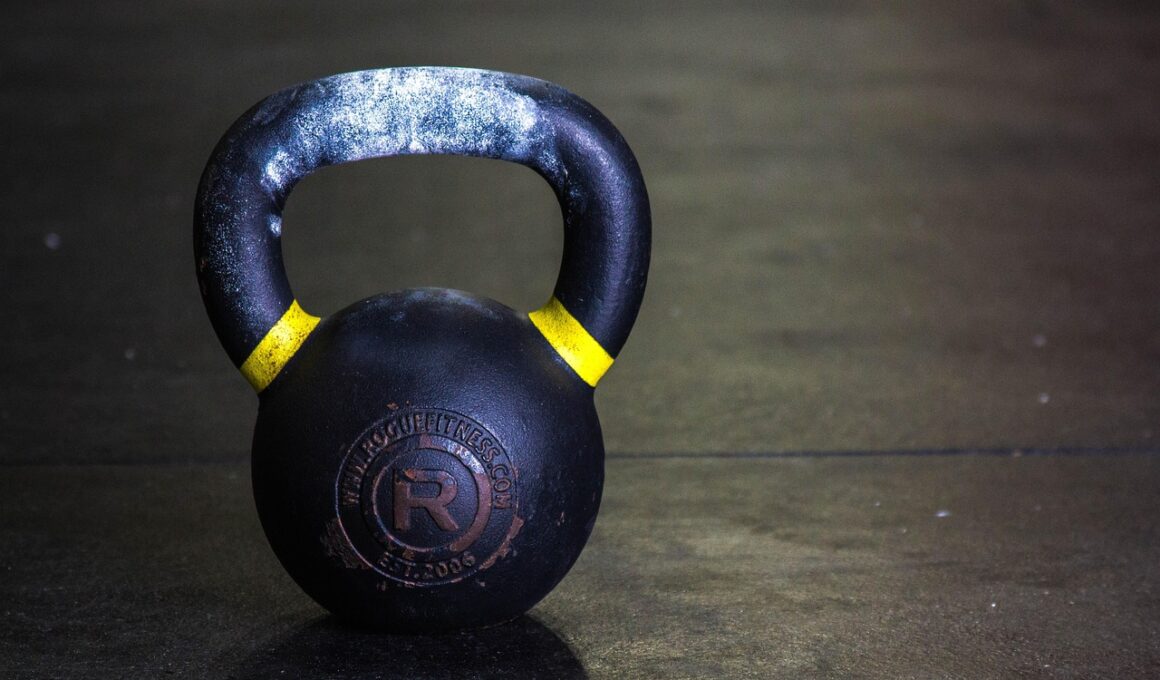Safe Practices for High-Rep Kettlebell Training Sessions
Kettlebell training can be a highly effective way to build strength, endurance, and flexibility when performed correctly. However, high-rep sessions elevate the risk of injuries due to fatigue and improper form. Hence, it is crucial to prioritize safety before diving into intense workouts. Incorporate a thorough warm-up routine to prepare muscles and joints. Dynamic stretches targeting the legs, hip flexors, and shoulders effectively loosen tight areas. Additionally, ensure you progress through your workouts incrementally, allowing your body ample time to adapt to the increased demands. Avoid jumping into heavy weights without proper acclimatization. Maintain proper hydration during training; dehydration can contribute to muscle fatigue and increase injury risks. Keep an eye on your techniques during each set, as form tends to deteriorate with high repetitions. Identify early signs of fatigue or discomfort, and do not hesitate to rest when needed. Recovery days are just as essential as training days, allowing muscles to repair and strengthen. Listen to your body, as it provides invaluable feedback for injury prevention. Acknowledge these guidelines for safe training!
Another crucial component of kettlebell training is ensuring you utilize proper equipment tailored to your needs. Selecting an optimal kettlebell weight one that challenges you without compromising your form is vital. Beginners should start with a lighter kettlebell. As they progress, choosing a heavier version becomes feasible. Additionally, regularly inspect your equipment for wear and tear, as damaged kettlebells can increase your risk of injury during workouts. Opt for kettlebells made of high-quality materials, ensuring durability and a comfortable grip. Utilize a variety of exercises to engage different muscle groups effectively, preventing overuse injuries. Specifically focus on incorporating exercises that enhance stability and core strength to support your kettlebell routines. Consider adding movements such as single-leg deadlifts or planks into your regime to promote injury prevention. Always be mindful of how your body feels during exercises, especially during repetitions. If pain arises, modify or cease the activity altogether. Take breaks as often as needed to avoid fatigue from high-rep training sessions. This approach ensures that you maintain the quality of your workouts while consistently challenging your physical limits.
Understanding Common Kettlebell Injuries
Familiarity with typical injuries associated with kettlebell training enhances awareness regarding personal limitations. Sprains and strains, particularly in the wrists and lower back, often occur during high-rep kettlebell workouts. Excessive repetition combined with poor form contributes significantly to these injuries. It is essential to identify the movements that trigger discomfort and be proactive in addressing them. Strengthening your stabilizing muscles reduces the likelihood of experiencing these injuries during high-rep sessions. Shoulder injuries are another concern, especially when performing overhead movements. Ensuring that the kettlebell’s weight aligns with your physical ability can prevent strain on the shoulder joint. Moreover, wrist tendinitis can develop due to an inappropriate grip or unsupported weight transfer. To safeguard against these risks, implementing wrist mobility exercises into your warm-up routine can be beneficial as well. When fatigue sets in, ensure you maintain your focus on technique rather than the number of repetitions. Prioritizing safety above competition enhances both performance longevity and fosters a more enjoyable training experience.
Proper breathing technique is another essential aspect of high-rep kettlebell training that contributes significantly to injury prevention. Incorporate controlled breathing into your workouts by exhaling during exertion and inhaling during relaxation phases. This practice not only promotes better oxygen flow but also aids in maintaining core stability throughout movements. Engaging your core muscles helps protect your spine and lower back, reducing injury risk as you perform high-rep kettlebell exercises. Be conscious of posture and alignment, particularly during swings or cleans. A straight back and engaged core minimizes the chances of strain as you lift and lower the kettlebell. Incorporate exercises focused on enhancing flexibility and mobility into your routine, specifically those targeting the hips and shoulders. Such exercises are vital for maintaining a full range of motion, preventing the tightness that often leads to injuries. Seek professional guidance if unsure about proper form, especially with advanced techniques. Engaging with a certified trainer can provide essential feedback to ensure safety and effectiveness in your training sessions as you progress with kettlebell workouts.
Rest and Recovery Practices
In the realm of kettlebell training, rest and recovery practices cannot be overstated. High-rep sessions put immense strain on muscles, making periodic recovery essential for injury prevention. Incorporating rest days into your training schedule allows muscles to rebuild and adapt to increased loads. Additionally, utilizing active recovery methods such as yoga or light aerobic exercises can help ease muscle soreness. On non-training days, focusing on nutrition and hydration remains vital for muscle repair. Consider incorporating whole foods rich in protein and anti-inflammatory properties into your meals to speed recovery. Each individual’s recovery needs differ; listen to your body when determining how much rest is necessary. Overtraining can lead to fatigue, weakness, alignment issues, or even injury, undermining your kettlebell progress. Acknowledging the signs of overuse and lowering intensity allows your body to recover effectively. Lastly, practice mindful movements during all sessions. Staying relaxed and maintaining mental awareness improves overall execution during workouts, ensuring that injury risks are mitigated. Incorporate mindfulness techniques such as meditation or breathing exercises into your regimen to promote overall well-being.
In addition to established practices, integrating kettlebell training into a broader fitness routine can ensure a balanced approach to your workouts. Combining activities such as resistance training, aerobic exercise, and flexibility training helps reduce wear and tear on specific muscle groups. For instance, cross-training reduces the likelihood of overworking certain areas, distributing training intensity evenly across your body. This balanced technique allows your muscles to recover from specific kettlebell movements while maintaining overall fitness. Furthermore, developing a tailored program that aligns with individual goals will yield better outcomes and lower injury risks. Setting realistic training goals and monitoring progress also keeps training exciting and engaging. Additionally, consider joining a kettlebell community or group sessions to gain inspiration and motivation. Sharing experiences with others encourages adherence to a training strategy while learning from peers improves techniques. Understand that consistency combined with variety is key to mastering kettlebells and preventing injuries. Regularly switching up your workout focus and trying out new exercises helps avoid stagnation while maintaining your interest in kettlebell training.
Conclusion: Prioritizing Safety in Kettlebell Training
To conclude, safe practices during high-rep kettlebell training sessions are essential for minimizing injury risks. By implementing effective warm-up routines and monitoring equipment, you set the foundation for success. Understanding and addressing common injury types will help in recognizing your body’s limitations while training. Employing proper breathing techniques, maintaining core stability, and emphasizing flexibility are key elements in preventing injuries. Additionally, focus on implementing recovery strategies and engaging in cross-training to create a well-rounded fitness habit. Remember, it is essential to listen to your body and acknowledge its feedback at every stage of your fitness journey. Rest as needed and remain open to professional guidance when uncertainties arise regarding form or techniques. Consistency combined with mindful engagement with kettlebell workouts will empower you to pursue your fitness goals, minimizing the risks of injury while maximizing gains. Ultimately, by prioritizing safety throughout your kettlebell training practices, you can enjoy the many benefits that this versatile form of exercise has to offer while achieving your performance objectives.
Incorporating safe practices rooted in proper techniques and recovery strategies leads to effective high-rep kettlebell training. Always embrace a proactive approach while refining your training habits. This ensures not only your safety but your long-term success with kettlebell workouts.


